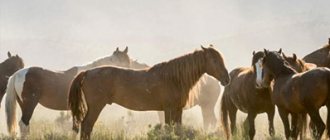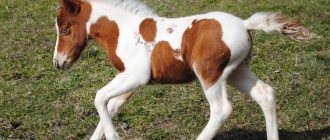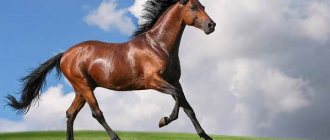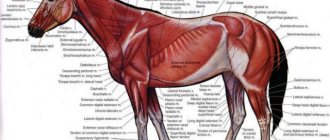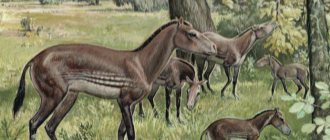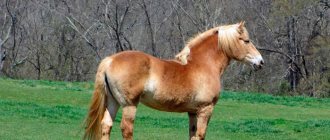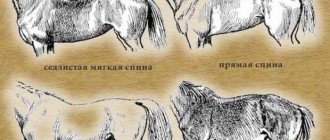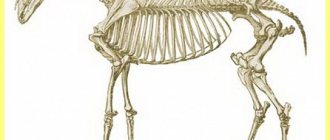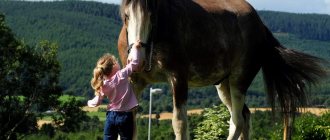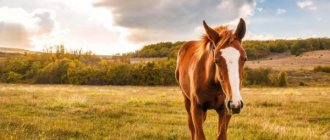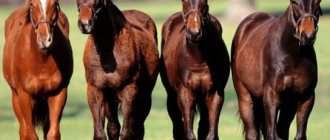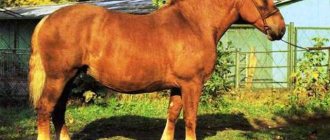It is hardly possible to find in our world an animal more noble, majestic and intelligent than a horse. Even in ancient times, people realized that by taming these unique creatures, they would make their lives much easier. And they succeeded magnificently in this matter, since the horses turned out to be faithful military allies and irreplaceable assistants in the field of agriculture, and they had no equal in draft power. From the wide variety of horses of different breeds, we have selected a list of the best so that you can get acquainted with their distinctive features and admire the beauty of these beautiful animals in vivid photographs.
Appearance and description
The appearance of the horse
The appearance of the horse
Appearance of the horse
Appearance of the horse
Appearance of the horse
A graceful animal with well-developed muscles and a strong constitution, it stands out among other representatives of the fauna for its slimness and plasticity. Horses belong to the class of herbivorous mammals, the order of equids.
Interesting fact : the horse's brain is quite small. Despite this, they are considered the smartest, intellectually developed animals, perfectly understanding humans and amenable to training.
The horse's muscular, round body is covered with short hair. The limbs are slender, strong and long. The oblong, elongated head is decorated with a lush mane. The tail consists of long hair. The color of horses depends on the breed. The most common ones are red, black, snow-white, and mousey. The color is uniform, but sometimes spots adorn the legs, head and body. As old age approaches, horses' manes and tails turn gray.
Frisian
Friesians cannot boast of their height (it varies from 160 to 170 cm), but they have incredibly luxurious manes, bushy tails and long brush-like hair on muscular legs.
These brushes cascade from the very hocks down to the very hooves - this is called freezing.
Nowadays all Friesians are black, but at the beginning of the 20th century many of them were bay, and in the Middle Ages they were also forelock.
In addition to their unusual beauty, these horses have a sociable and friendly character, and that is why they are often made into circus and film actors, harnessed to holiday carriages, and attracted to photo shoots.
Sports competitions also rarely take place without the participation of Frisians.
When the horse appeared
Drawing of Eohippus, the animal from which horses descended.
Based on long research and study of partial organic remains, scientists have come to the conclusion that the ancestors of horses have existed on Earth since the Eocene era. They lived in the tropics of North America and the forests where modern Western Europe is located.
The horse that lived 60 million years ago bears little resemblance to the stately and tall horse of today. The forest creature was no larger than an ordinary dog, had a curved back, and a very small head on a short neck. The remains were discovered in the middle of the 19th century, they were named Eohippus (the first horse). The animal's diet consisted of leaves and soft fruits.
During the Eocene and Oligocene periods, the animal increased its population and inhabited parts of America and Eurasia. The Miocene era brought with it changes in climate and, accordingly, in the structure of the ancient ancestors of the horse. The animal's height increased to 120 cm, its jaws became more powerful, and its head elongated.
About 4-4.5 million years ago, the species Equus appears, considered the ancestor of all species of donkeys, zebras and horses.
Mongolian
The Mongolian horse (aduu) is a fairly old breed of horse; its appearance has remained virtually unchanged since the time of Genghis Khan. According to Amanda Hund, this breed of horse has special significance in Mongolian culture.
What is special about the Mongolian horse breed? The animal is unpretentious in maintenance and lives on the street all year round. The horse can easily tolerate temperatures from +30 °C to –40 °C. Their height reaches 125−135 cm. Stocky, with a large head and short legs.
Mongolian: Wikipedia
The Mongolian horse is used as a riding horse. Horses of this breed are known as the basis of Genghis Khan's army. In modern Mongolia, they are used for horse racing, and the national drink, airag, is made from mare’s milk.
What does it eat?
The main diet of a horse is grass.
Horses are herbivores. The basis of their diet is food of plant origin (grass, fruits, vegetables, leaves, roots, grains). They love to eat young stems, tree bark, seeds and nuts.
The feed for domestic horses must include: oats, corn, beets, carrots and apples. In the summer, horses graze on pastures, eating fresh grass and leaves, they receive the micro and macroelements necessary for full growth and development. With the onset of cold weather, hay replaces fresh vegetation.
Threats
Populations of domestic horses, except for Przewalski's horses, have unfortunately become extinct. But there are more than enough domestic horses bred throughout the world as part of horse breeding. And they, in turn, easily return to their wild state and way of life. Therefore, the population size can be considered stable and does not cause concern.
How long does he live?
The lifespan of horses depends on the breed, living conditions and main purpose. According to average statistical data, in domestic individuals this parameter ranges from 25 to 30 years.
Thoroughbred horses live longer than others: 30-35 years, heavy working horses - 10-25, participants in sports competitions - 18-20. And little ponies delight a person 37-39 years old.
Interesting fact : a horse named Old Billy is considered the record holder for the longest life expectancy among horses: 62 years. The longest-liver among sports horses is the thoroughbred stallion Prospect Point: 38 years.
Wild animals rarely survive to old age. An important role in this is played by the constant struggle for survival and climatic conditions. The life cycle of a wild horse is no more than 10-12 years.
Trakehner
The Trakehner horse is a German draft horse breed. This is the only breed among half-bred breeds that is bred in purity without foreign blood. The breed began to be bred in the 18th century in East Prussia in the village of Trakehnen. It was produced for Prussian cavalry units.
Trakehner: Wikipedia
What are the differences between the Trakehner horse breed? The former war horse is suitable for sporting purposes. The height of the stallion at the withers reaches 162-165 cm, the body has elegant dryness and regular lines. The horse is bred in Germany, Europe, the USA and New Zealand. She can be recognized by her brand name in the form of a double elk horn on her left thigh. Needs regular shoeing and brushing.
Currently, Trakehnens are exclusively sport horses. Their calm nature makes them suitable for both show jumping and dressage. The stallions Ash and Abdullah became Olympic champions.
Horse structure
The structure of a horse
The horse has a rather unusual structure, which helps it to be resilient and cover long distances with great speed.
The length of the animal's head is approximately 2/5 of the total height of the animal. The skull is elongated, with nostrils and a mouth at the end. Powerful jaws are hidden under the lips. A horse has 36 to 40 teeth. The animal's eyes are large and long eyelashes grow on the eyelids. At the top there are ears that can turn towards the source of noise. The head is supported on a massive neck, at the top of which a long mane grows.
The horse has a massive and muscular body that can withstand high loads. From the withers to the sacrum, along the back, the animal has a wide dorso-lumbar line. The horse's hindquarters are sloping. The back has a slightly concave shape. The belly is convex.
The horse's limbs are designed in such a way that the center of gravity falls on the forelimbs. At their end are hooves.
Appaloosa
These horses, bred in America, are characterized by an unusual forelock color. Appaloosa's are easily recognized by their spotted coat.
In equestrian sports, horses are used due to their beauty, endurance and easy-going nature - thanks to the latter quality, they are often chosen as family horses.
An Appaloosa would probably look very natural next to a Dalmatian dog, since the spots on their fur are somewhat similar.
An Appaloosa horse can grow to a maximum height of 155 cm and weigh 550 kg. Although not particularly large in size, the body and legs of Appaloosians are muscular, and the head is well developed.
A beautiful curve of the neck with a chic mane, a wide chest, a straight back ending in an oval croup and a luxurious tail, striped hooves, a white edging around the iris, spots decorating the powerful body - this is a brief description of the Appaloosa beauties.
How do horses sleep?
Sleeping domestic horse Horses
sleep lasts almost half a day. They can fall asleep either standing up or lying on their side. Wild horses prefer the first option. In the event of an attack by wild animals, they will be able to quickly wake up and fight back the attackers. Domestic horses living in a specially equipped stable, on the contrary, do not care about their safety while sleeping and rest lying down.
Small stallions prefer to sleep lying on the ground. Adults organize a constant guard for safety purposes. Usually, in large herds, several horses remain to guard their sleeping brothers.
Icelandic
The Icelandic horse is a short horse, whose height at the withers reaches 132 cm. It has different colors, from red to bay. Icelanders have about 100 shades of animal color. The breed was brought by the Vikings to Iceland in the 9th–10th centuries, as it easily fit in their ships.
Icelandic: Wikipedia
What features distinguish the Icelandic horse? These are very smart horses. They have excellent body balance, thanks to which they can easily overcome any obstacles. During their history, the animals have never encountered predators, so they easily trust people and have a calm and friendly character. Suitable for herd keeping.
Reproduction
Horse with foal
At the age of 2-3 years, horses reach sexual maturity. Under natural conditions, the mating season begins in the spring and lasts until mid-summer. At this time, mares ready for mating secrete a liquid with a specific odor that attracts the stallion.
Interesting: Why can’t a horse be given water immediately after a race? Description, photo and video
Pregnancy in horses lasts 11 months (335-340 days). After the due date, the mares give birth to 1 foal. Twins are a fairly rare occurrence.
A newborn is born clumsy, unsteady on its limbs, but foals are visible from the first minutes of life. After a few hours, the babies adapt and can already stand and follow their mother. The duration of breastfeeding is 4-6 months.
Kabardinskaya
The Kabardian, or mountain horse, is one of the oldest aboriginal eastern horse-drawn breeds, which were cultivated by the Adygs (Circassians). They called it Circassian so as not to confuse it with the Ukrainian breed of the same name. Distributed in Bashkiria, Tatarstan and the Chelyabinsk region.
Kabardinskaya: Wikipedia
What is special about the Kabardian horse breed? She maintains her balance well, thanks to which she confidently moves in the mountains along narrow paths and overcomes steep descents and ascents. Even with 150 kg of cargo, a Kabardian is able to walk up to 100 km in one day in high mountain conditions. They are noticeably different from other breeds with muscular legs and a special “cup” shape of the hooves.
The Kabardian horse grows to 152−157 cm at the withers. Today, horses are used by border guards and tourists for mountain horse treks and horse riding. Suitable for herd keeping.
Types of horses
The classification has changed several times. The latest taxonomy defines Przewalski's horse and domestic horse into different species. Kulans are combined with donkeys, and several species of zebras are also included. Taking into account all the changes, the genus of horses was systematized and 7 main species were obtained.
Wild horse (Przewalski's horse)
Przhevalsky's horse
Society first heard about the new species at the end of the 19th century, when N.M. Przhevalsky brought a gift (a horse skull and skin) received from a Kazakh hunter on the Russian-Chinese border. Research has shown that this is a new species of horse, differing from the others in the number of chromosomes (instead of 64, 66 were found in it). The natural habitat of wild horses was Asia, but now they are not found in nature. Currently, there are 2 thousand purebred Przewalski's horses living around the world.
Domesticated horse
Domesticated horse
Representatives of the species are characterized by long limbs and neck, and their hooves are hard. The colors of domesticated horses are different. The most common colors are light brown, gray, and red-brown. There are no general parameters for body weight, height and size for this species: they depend on the breed. They live in all countries of the world.
Feral horse
Feral Horses
Some habits are quite similar to domestic horses. The body weight of representatives of this species varies from 300 to 450 kg. The height of an adult does not exceed 160 cm; sometimes short animals with a height of 100-110 cm are found. A characteristic feature of the species is a rather short tail. Feral horses come in different colors: white, with orange-brown spots, black, brown. The largest population lives in South and North America.
Kiang
Kiang
A large animal with an unusual color: the lower part of the body and limbs are white, and the back and head are reddish-brown. In summer the color becomes brighter, but with the onset of cold weather it fades and acquires a uniform brown color. The kiang's tail is quite short and resembles a donkey's. The height of horses does not exceed 142 cm, and weight can vary from 200 to 430 kg.
The largest populations live on the mountain plateaus of Tibet. They are also found in Nepal and India, but not in such quantities.
Kulan
Kulan
Appearance is more reminiscent of a donkey, but other characteristics are similar to a horse. The kulan is quite short - 125 cm, and its body weight does not exceed 300 kg. The color and length of the hair varies depending on the time of year: in winter the coat is longer and yellow-brown in color, in summer it becomes shorter and acquires a reddish-brown tint. The lower part remains white throughout the year.
Kulans live on dry plains of deserts and semi-deserts. The largest populations remain in Turkmenistan and Northern China.
Faroe Islands horse
A unique species of horse lives on the Faroe Islands.
Of all known species, it is considered the most ancient. The Scandinavians and early Celts brought short horses to the islands. At the beginning of the 20th century, only 5 representatives of this species were discovered, but thanks to breeders, their number is now about 50 individuals.
The height of an adult pony is no more than 124 cm, weight – 250-270 kg. The most common species are brown, black or speckled. Unique animals live only on the Faroe Islands.
Mustang
Mustangs are powerful and hardy horses.
A wild, endangered species of horse lives mainly in America, a few individuals survive in Spain, and a small population lives on Vodny Island (Russia). Graceful, muscular horses are quite difficult to tame. Domesticated animals retain their wild nature and are practically impossible to train. This species was created by natural crossing of English, French and Spanish breeds.
The height of an adult horse does not exceed 150 cm, and its weight is 400 kg. Mustangs are quite durable, capable of developing high speed and maintaining it for a long time. In nature there are bay, red, piebald and 3-color suits.
Frieze
The Friesian horse is a Dutch breed, “the black gold of Holland.” Bred in Friesland, first mentioned in the 13th century, now bred in Europe and America. Horses range in height from 150 to 162 cm and have an elegant appearance. A memorable feature is the long thick brushes on the legs, the so-called friezes. Suitable for keeping in stables, somewhat picky about feed.
Friesian horse: Wikipedia
What is special about the Friesian horse? Today, friezes are decorative horses. They are energetic, but balanced and calm. They are often used for festive or ceremonial carriages, photo shoots, and filmed.
Horse breeds
Since ancient times, people have used animals for their own purposes. Among them were horses, since man was able to tame them, despite their rebellion. Later, numerous breeds began to emerge. They differ in the following appearance features:
- Color. Varies from light to dark shades.
- Wool. It can be red, brown or yellow, less often – white. There are sometimes distinctive spots on the body.
- Size and build. Depending on the breed of the horse, its appearance will also change. There are very low ones, reminiscent of ponies, and tall horses.
Almost all horses have hoofs that resemble an oval in shape. They also have a long tail, high slender limbs, a strong and powerful body, and a slightly elongated neck. When it gets cold, the animal's fur becomes coarser and warmer; it warms the horses during severe frosts. By summer it turns into smooth and thin.
Animals are also distinguished by their purpose, which depends on the personal qualities, character of the horse and physique.
Trakehner horse
Trakehner horse
The breed appeared in the 18th century and was created specifically for the army. The Trakehner horse is one of the most durable and strong. Horses often participate in all kinds of competitions and are used for regular riding. The horses are bred in Germany, where the purebred nature of the breed is valued.
It reaches a height of approximately 160-165 cm. The appearance of the animal is not remarkable, but speaks of pride and confidence. The horse is good-natured and gets along well with people.
Arabian horse
Arabian horse
The breed is one of the oldest. Appeared on the territory of the Arabian Peninsula. The appearance of the horse is different from its counterparts. The body looks quite small compared to others that are lighter. The color can be different; the rarest horses to be found are silver or black.
The Arabian horse is often used for sporting competitions. She is considered an excellent horse, hardy and fast.
Akhal-Teke horse
Akhal-Teke horse
An ancient purebred breed was bred by the nomads of Central Asia. The horses are quite tall. The hairline is almost invisible on the thin body of the animal, the hair is sparse and smooth.
Interesting: Can sharks sleep?
Outwardly, the horse may seem weak, but it is a magnificent horse. It is distinguished by its endurance, tolerates hot weather well, and is extremely sensitive to frost. The horse is attached to its owner, but only if he can really rein it in. Otherwise, the animal will not obey commands and will act according to its instincts.
Friesian horse
Friesian horse
One of the oldest European breeds, bred in the 16th century in Holland. The height of the horse is about 160-170 cm. It is distinguished by a luxurious mane and a bushy tail, muscular legs covered with brushes. Horses are sociable and friendly; thanks to their docile nature and unique appearance, they are often seen in circus arenas. Horses are also used for regular horse riding and sports competitions.
Mongolian horse
Became Mongolian horses
Despite their small size, the horses have a strong build and are distinguished by endurance. They reach a height of 145 cm. Horses are often confused with ponies, but this opinion is wrong.
The exact origin is unknown; according to data, the breed originated in Asia. The body color is predominantly brown. During the cold season, the coat becomes thicker, which prevents horses from freezing from the cold.
Yakut horse
Yakut horse
Squat, short horses in appearance are more reminiscent of ponies. They reach a height of less than 150 cm. The horse's body is covered with thick, warm hair, making it more frost-resistant. The animal has excellent orientation even in unknown terrain and has strong but short legs.
Interesting fact : Yakut horses feel comfortable at low temperatures, even dropping to -50 0C. Among their descendants there is a tundra breed, and horses are bred in the north of Russia, which is why they are not afraid of severe frosts.
Thoroughbred riding horse
Purebred riding horse
The breed was bred in England around the 16th century, and soon spread throughout the world. The color may vary, but regardless of appearance, horses remain wonderful horses. They are fast and resilient, perfect for participating in equestrian competitions and learning to ride.
Interesting fact : the unique body structure of a thoroughbred horse speaks about its purpose. She was born to race. A horse's heart can withstand heavy loads, and its lung capacity is several times greater than that of others.
Anglo-Norman
Anglo-Norman
Bred in France and has always enjoyed particular popularity in its homeland. The height of an adult exceeds 160 cm, the horses are quite large and strong. The color is predominantly bay, but shades may vary. The appearance of the horse speaks of grace and noble blood. Horses are used for various purposes. Some serve the French cavalry; they are also suitable for ordinary riding.
Percheron
Percheron
The breed appeared in the 19th century in France. It is still considered one of the most common in its homeland. The Percheron is strong and resilient and can withstand almost any physical activity.
The height at the withers of an adult reaches 175 cm. As a rule, the color of horses is gray, less often – black. Horses have quite powerful limbs and a massive muscular body. Nature also rewarded them with a luxurious mane.
Shetland pony
Shetland Pony
Where exactly the breed came from is still unknown, it supposedly came from the Shetland Islands. A well-built, strong and strong horse, its appearance resembles a small pony. At the withers it reaches a maximum of 110 cm, while the weight can reach up to 180 kg.
The Shetland pony has powerful short limbs and a long mane and tail. The horse's entire body is covered with thick, warm hair. The eyes are usually dark, but there are ponies with blue ones.
Oldenburg horse
Oldenburg horse
The breed was bred back in the 17th century, at that time it was used mainly for agricultural work. A few decades later, the Oldenburg horse also began to be used for riding.
The breed is classified as heavy. Horses have well-developed muscles, trunk, chest and limbs. An adult male can reach a height of 180 cm. Oldenburg horses do not like to sit still; they require active care and attention.
Oryol trotter
Oryol Trotter
Horses of this breed are often called the symbol of the Russian horse. They were developed back in the 18th century. Orlovites are distinguished by an ideal graceful gait, a long, elongated back and strong, developed limbs. An adult horse can reach a maximum height of 170 cm.
Well-built, slightly temperamental, but good-natured and friendly horses also have a beautiful lush mane. Color may vary.
Orlovites have no analogues in the world; they are hardy and fast. The horses are great for casual riding enthusiasts and athletes.
Clydesdale
Clydesdales
At the beginning of the 20th century, horses had a rather weak and small body. But now Clydesdale horses are known as powerful, energetic and massive horses. Most often they are bay, less often you can see piebald, black or gray. Most individuals are distinguished by light spots on some parts of the body, especially on the limbs. The horses have a firm, confident gait and a large build.
Bityug
Bityug
is a Russian breed of horse that appeared in the 18th century and got its name from the river of the same name. Bityug is considered a heavy horse; they are quite large and have well-developed muscles. The height of an adult individual reaches almost 180 cm. But at the same time, bityugs have rather weak legs and back. There were practically no purebred horses left; after several centuries the breed began to disappear.
Don horse
Don Horse
The first representatives of the breed were not tall and large in build, but over time this changed. The body looks quite elongated and massive; Don horses reach a height of approximately 165 cm.
Donchak people have always been famous for their good health, endurance and speed. The horse adapts perfectly to life in the steppe and can endure great physical exertion. They are not picky and easily find common language with other animals and people. This breed is often chosen for horse riding training.
Bashkir horse
Bashkir horses
The indigenous inhabitants of the Urals come from local steppe and forest breeds. The uniqueness of the Bashkir horse is its unpretentiousness and endurance. They eat solid food, are not afraid of severe frosts and are fully adapted to the harsh northern conditions. The average height of horses is 145 cm, they weigh up to 470 kg.
Interesting: The most expensive horse breeds in the world - list, cost, photos and videos
Representatives of this breed have a calm and flexible temperament. Local residents use them in the household; they are irreplaceable for transporting goods and riding horses.
Hutsul pony
Hutsul pony
The breed is bred in Western Ukraine, the Carpathians and several countries in Eastern Europe. Hutsulik is a domestic mountain horse. The height of horses is quite short: stallions are no more than 145 cm, and mares - 140 cm. A distinctive feature is small but hard hooves that do not require shoeing. Mostly representatives of the breed are bay, with a dark longitudinal stripe on the back, but there are mousey, gray, red and black colors.
Hardy, strong horses are suitable for harnessing and riding. Europeans use them in sports competitions, tourism and hippotherapy.
Camargue
Camargue
Half-wild horses live in the Rhone River delta (France). Although this breed is considered one of the most ancient, it was recognized only in 1968.
Horses of a light gray color with a rough head are often called “sea horses.” The Camargue are balanced, calm and resilient. For a long time they are able to stay in water and feed only on brackish herbs. They are quite short in stature; an adult horse is 150 cm at the withers.
Polish Konik
Polish Konik
The ancestors of this breed are considered to be forest tarpans. A medium-sized horse, height at the withers - no more than 125-130 cm. The main color is a monochromatic mouse, and on the back there is a black belt running along the spine. The mane and tail are dark, sometimes light gray or white. The Polish Konik's limbs are quite short. Zebra stripes are visible slightly above the ankle joints.
They live in their natural environment. The largest herds live in Belovezhskaya Pushcha (Poland), but they are also found in Belarus. In zoos in Europe you can often find Polish conics.
Marwar horse
Marwar horse
The breed originated in India, near the city of Marwar and in the northwestern part of the country, near the border with Afghanistan. The height of an adult reaches a maximum of 165 cm; the horse is often classified as a pony due to its small size. Horses have unusually shaped ears and different colors. Marwar horses are hardy and fast. They are used for horse riding and agricultural work.
Yakutskaya
Of course, even now, in some hard-to-reach places, horses continue to be used as riding or draft power.
But all horse breeds in modern times have a different mission - so that people can admire their unique beauty and watch with delight their graceful gait.
Now the number of horse breeds bred around the world has already exceeded a thousand, and each of them has its own differences. All of them are classified into one of the existing four types of breeds. According to the classification, horses are divided into riding horses, light draft horses, heavy draft horses and pack horses.
The appearance of this native breed was influenced by folk selection coupled with natural selection.
The breed is characterized by high frost resistance. It is for this very reason that Yakut horses are most common in this harsh region.
The horse has a fur length of eight to fifteen centimeters, and thanks to its thick undercoat it does not freeze and can even get grass covered with snow for food - it does this with the help of its hooves.
Yakutia is a very cold region in the autumn-winter season, when air temperatures can reach -50°C.
In the summer, the thermometer there often rises to above 30°C. But, despite such a variation in the temperature range, this breed of horse does not need shelter: they exist perfectly in the open air all year round.
A person doesn’t even have to give them food - they are quite capable of feeding themselves. Yakut horses can be called long-lived, since at the age of five they become adults, and perform their functions on average until twenty-five years.
These small horses (their height is about 150 cm), similar in appearance to ponies, are very hardy and smart.
Horse care
Horses require regular care.
It is possible to ensure a long healthy life for an animal only with the right approach to its maintenance. Spacious stables are built for horses and paddocks are made for walking. A building with stalls must be heated in winter and ventilated on hot days.
Rules of maintenance and care:
- Hygiene procedures. Every day, the horse's mane and tail are combed out, and the coat is brushed with a special brush. In cold weather, dry cleaning is enough, but with the onset of summer, horses need bathing.
- Nutrition. Feeding is carried out at least 3 times a day. Horses have a sensitive digestive system, so sudden diet changes are not recommended. Drinking bowls should always be filled with clean and fairly warm water (15-18 0C).
- Cleaning the stables. Cleaning is carried out 1 or 2 times daily.
- Walking. Regardless of the time of year, a horse needs time in the fresh air. The duration of the walk is at least 3 hours. The body of these beautiful graceful animals is designed for movement; inactivity has a negative impact on health.
Horses are kind and affectionate animals. They will respond with devotion and love to the kindness and attention of their owner.
Real Shires
The British are the trendsetters in the breeding of many breeds of domestic animals. Over the centuries, a good school of breeding work has developed there. Back in the 17th century, the heavyweight Shire breed was bred. Then strong animals were needed for heavy knights.
Real mammoths are recorded in the history of horse breeding. In 1846, the British could boast of a horse that reached an incredible size - 2 meters 19 centimeters. The growth of a huge handsome man with shaggy legs could delight anyone.
Of course, it’s difficult to imagine such a horse galloping, but its gait is incredibly soft. That is why today they love to use this breed for walking.
Human interaction
Man and horse have been getting along well for several thousand years.
More than 5 thousand years ago, horses were domesticated. At first, people used their skins to insulate their homes and made clothes and shoes from them, and the meat was eaten. Later, people figured out how to use smart and strong animals in agriculture and use them for transportation. They were indispensable helpers in difficult war times.
Interesting fact : horses were first used on the battlefield in the 3rd century BC. e. At the end of XI the horsemen appear. Horse riding gained popularity during the time of the knights (13th century).
Thousands of years later, the importance of horses in human life is only growing. They are involved in many industries: agriculture, tourism, sports, light industry. Kind, affectionate animals help people treat many diseases. The effectiveness of hippotherapy has already been proven by scientists.
Latvian
When horse breeders decided to create a Latvian horse breed, they used Oryol trotters, German half-breeds, Brabançons and representatives of other breeds for selection.
Most of the large, beautiful Latvian horses are bay in color, but there are also black, and karak, and gray. Thanks to their powerful build and high height (up to 170 cm), horses of this breed exhibit excellent athletic qualities.
The Latvian horse has a wide head, a straight or slightly flattened profile, small ears, but huge eyes.
She has an excellent exterior, thanks to her elongated body, sloping and long croup, convex withers, massive back, and broad chest.
High performance, harmonious build and good disposition have led Latvian horses to versatility: they are used in equestrian sports, horseback riding, tourism, and escort.
Horse running
A horse can accelerate up to 60 km/h.
The manner of movement of animals is usually called a gait. Depending on the style of gait and speed, there are 4 main types:
- The step is unhurried and the slowest. The horse alternately rearranges its hind and forelimbs, while they do not hang in the air for long. Average speed – 2.5 m/s.
- Trot - the limbs are rearranged crosswise (for example, the horse simultaneously raises the left front and the right rear). This kind of running is typical for harness horses. Movement is carried out at a speed of 35-45 km/h.
- Galloping is the fastest way to move. The horse makes a series of leaps, hovering in the air for several seconds. Horses that have undergone training can move in this way for a long time. This type of gait is often used in the circus (short arena) and at the hippodrome (frisky). At races, a horse reaches speeds of up to 60 km/h.
- Ambling is the most original running. The horse masters it only during training. Not every horse can master ambling, so judges at shows value these skills quite highly. The horse's movement begins with the simultaneous release of a pair of left limbs, then a change occurs.
Trainers come up with new gait styles. As a result of long, grueling training, horses master passage, reverse canter, Spanish walk, telp, piaffe and even canter on 3 legs. You can see unusual types of gaits at sports competitions and circus performances.
Knabstrupper
If you know Cruella de Vil, do not under any circumstances tell her about the existence of a unique horse with a Dalmatian color. Knabstruppers are not only beautiful, but also incredibly kind - which is why they are often exploited to work in circuses.
This horse is not known for its physical strength and cannot be used as a draft horse, but they have proven themselves to have good health, endurance, trainability and developed intelligence. They make excellent draft horses - the features of their exterior allow them to work tirelessly if the load is not too heavy. The knabstrupper is also suitable for horse riding, although it is used much less frequently.
Horse Frankel
Photos of this thoroughbred English horse adorn many websites dedicated to horses. Of course, because he is not only a very beautiful horse, but also the most expensive in the world. He has 14 victories in competitions and no losses. The stallion is already more than 5 years old. He was last seen competing in 2012.
Now Khalil Abdullah (the owner of the animal) can get a huge amount of money for Frankel. But the owner does not even plan to part with his pet. Trainer-rider Henry Cecil also believes that the best stallion in the whole wide world cannot be found anymore. At the moment, the most beautiful stallion does not participate in racing, but is only an elite sire.
Akhal-Teke
Akhal-Teke is a unique riding horse breed, whose history goes back more than 5,000 years - with all the characteristics of the breed preserved. The appearance of the Akhal-Teke distinguishes it from the rest of its brothers.
- Height: 147-163 cm.
- Weight: 400-450 kg.
The Akhal-Teke horse was bred by the Teke tribe on the territory of modern Turkmenistan, in the Ahal oasis - this is how it got its name. Among the peoples who inhabited this area in ancient times, the horse was revered as a special animal, and the goal was to breed a breed that was superior to all others in strength and beauty. The golden-colored Akhal-Teke was especially revered, which is obviously associated with the worship of the sun.
Today Russia has the best population of Akhal-Teke horses - they are bred in the Stavropol Territory, in the Moscow Region.
The body of the Akhal-Teke is elongated, dry, with graceful lines. The muscles are well developed. The legs are long and thin. The profile is hook-nosed, the eyes are large, expressive, and slightly slanted. The neck is straight or S-shaped - the so-called “deer”. The hair is thin and silky. The mane is sparse or practically absent.
Akhal-Teke horses are red and gray; Isabella and nightingale colors are rare. Regardless of color, there is a golden or silvery sheen to the coat.
Akhal-Teke horses are called “golden” horses. Because of the brilliance or the old legend, according to which in ancient times they gave as much gold for an Akhal-Teke as he himself weighed.
As it was formed in hot desert conditions, this breed, despite its external sophistication, is distinguished by great endurance: it easily tolerates thirst and temperature ranges from −30 to + 50 °C.
The Akhal-Teke has a fiery temperament. This proud, handsome man knows his worth and demands an appropriate relationship. Rudeness and neglect will never be forgiven. He is obstinate and needs a special approach: not everyone can work with him - you need a smart and patient person. Sometimes he won’t let anyone near him except his owner.
Akhal-Teke horses are very good for riding - their running is easy and tireless for the rider. They participate in many types of equestrian sports. They have all the classic prizes, in particular the Derby.
